Approximation search
This is analogy to binary search but without its restrictions that searched function/value/parameter must be strictly monotonic function while sharing the O(log(n)) complexity.
For example Let assume following problem
We have known function y=f(x) and want to find x0 such that y0=f(x0). This can be basically done by inverse function to f but there are many functions that we do not know how to compute inverse to it. So how to compute this in such case?
knowns
y=f(x) - input functiony0 - wanted point y valuea0,a1 - solution x interval range
Unknowns
x0 - wanted point x value must be in range x0=<a0,a1>
Algorithm
probe some points x(i)=<a0,a1> evenly dispersed along the range with some step da
So for example x(i)=a0+i*da where i={ 0,1,2,3... }
for each x(i) compute the distance/error ee of the y=f(x(i))
This can be computed for example like this: ee=fabs(f(x(i))-y0) but any other metrics can be used too.
remember point aa=x(i) with minimal distance/error ee
stop when x(i)>a1
recursively increase accuracy
so first restrict the range to search only around found solution for example:
a0'=aa-da;
a1'=aa+da;
then increase precision of search by lowering search step:
da'=0.1*da;
if da' is not too small or if max recursions count is not reached then go to #1
found solution is in aa
This is what I have in mind:

On the left side is the initial search illustrated (bullets #1,#2,#3,#4). On the right side next recursive search (bullet #5). This will recursively loop until desired accuracy is reached (number of recursions). Each recursion increase the accuracy 10 times (0.1*da). The gray vertical lines represent probed x(i) points.
Here the C++ source code for this:
//---------------------------------------------------------------------------
//--- approx ver: 1.01 ------------------------------------------------------
//---------------------------------------------------------------------------
#ifndef _approx_h
#define _approx_h
#include <math.h>
//---------------------------------------------------------------------------
class approx
{
public:
double a,aa,a0,a1,da,*e,e0;
int i,n;
bool done,stop;
approx() { a=0.0; aa=0.0; a0=0.0; a1=1.0; da=0.1; e=NULL; e0=NULL; i=0; n=5; done=true; }
approx(approx& a) { *this=a; }
~approx() {}
approx* operator = (const approx *a) { *this=*a; return this; }
//approx* operator = (const approx &a) { ...copy... return this; }
void init(double _a0,double _a1,double _da,int _n,double *_e)
{
if (_a0<=_a1) { a0=_a0; a1=_a1; }
else { a0=_a1; a1=_a0; }
da=fabs(_da);
n =_n ;
e =_e ;
e0=-1.0;
i=0; a=a0; aa=a0;
done=false; stop=false;
}
void step()
{
if ((e0<0.0)||(e0>*e)) { e0=*e; aa=a; } // better solution
if (stop) // increase accuracy
{
i++; if (i>=n) { done=true; a=aa; return; } // final solution
a0=aa-fabs(da);
a1=aa+fabs(da);
a=a0; da*=0.1;
a0+=da; a1-=da;
stop=false;
}
else{
a+=da; if (a>a1) { a=a1; stop=true; } // next point
}
}
};
//---------------------------------------------------------------------------
#endif
//---------------------------------------------------------------------------
This is how to use it:
approx aa;
double ee,x,y,x0,y0=here_your_known_value;
// a0, a1, da,n, ee
for (aa.init(0.0,10.0,0.1,6,&ee); !aa.done; aa.step())
{
x = aa.a; // this is x(i)
y = f(x) // here compute the y value for whatever you want to fit
ee = fabs(y-y0); // compute error of solution for the approximation search
}
in the rem above for (aa.init(... are the operand named. The a0,a1 is the interval on which the x(i) is probed, da is initial step between x(i) and n is the number of recursions. so if n=6 and da=0.1 the final max error of x fit will be ~0.1/10^6=0.0000001. The &ee is pointer to variable where the actual error will be computed. I choose pointer so there are not collisions when nesting this and also for speed as passing parameter to heavily used function creates heap trashing.
[notes]
This approximation search can be nested to any dimensionality (but of coarse you need to be careful about the speed) see some examples
In case of non-function fit and the need of getting "all" the solutions you can use recursive subdivision of search interval after solution found to check for another solution. See example:
What you should be aware of?
you have to carefully choose the search interval <a0,a1> so it contains the solution but is not too wide (or it would be slow). Also initial step da is very important if it is too big you can miss local min/max solutions or if too small the thing will got too slow (especially for nested multidimensional fits).


